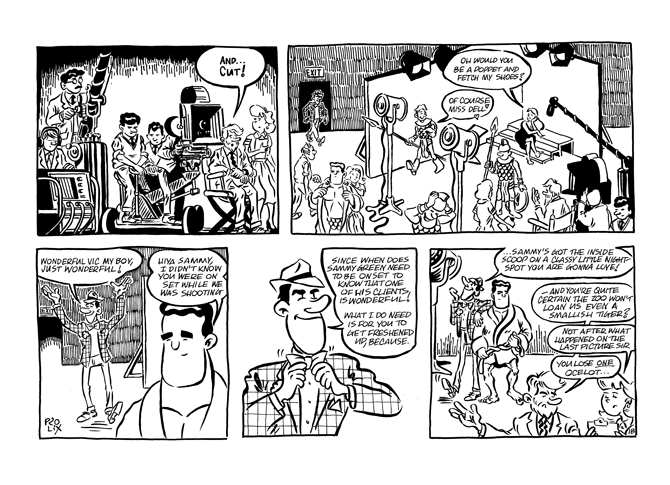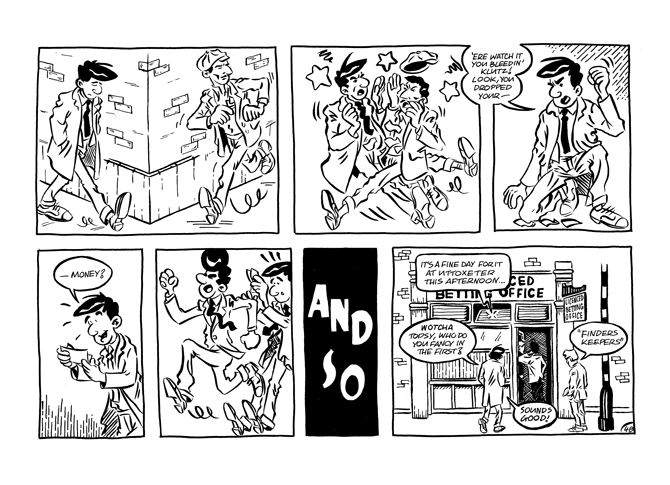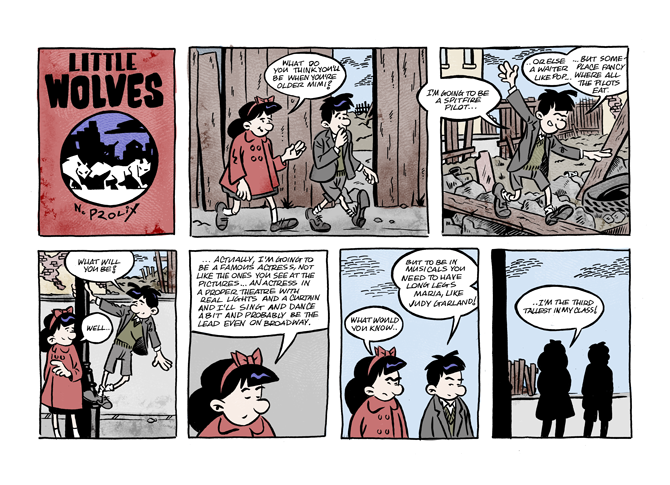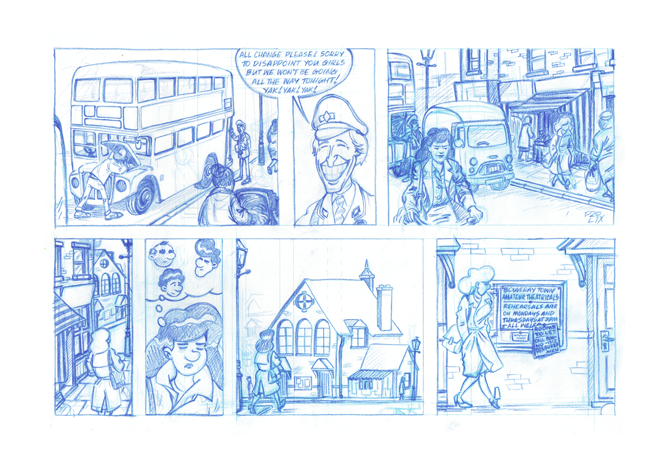“It’s shaped by my nostalgia for that post-war British popular culture more than the historical reality of the period” Nick Prolix reveals all about his 60s set webcomic The Sheep And The Wolves and Slang Pictorial
 Set in the seedy underbelly of 60s London, Nick Prolix’s webcomic The Sheep And The Wolves and it’s print spin-off Slang Pictorial, mixes vintage crime and newspaper strip capers as be-quiffed hitman Jimmy struts around town impressing the birds and trying to make a name for himself as an underworld player. Having met up with Nick at True Believers, we decided to pay a visit to his Cockney manor, have a cup of rosie lea and a bit of Frank and Pat about all things Sheep And Wolves!
Set in the seedy underbelly of 60s London, Nick Prolix’s webcomic The Sheep And The Wolves and it’s print spin-off Slang Pictorial, mixes vintage crime and newspaper strip capers as be-quiffed hitman Jimmy struts around town impressing the birds and trying to make a name for himself as an underworld player. Having met up with Nick at True Believers, we decided to pay a visit to his Cockney manor, have a cup of rosie lea and a bit of Frank and Pat about all things Sheep And Wolves!
Your web comic The Sheep and The Wolves is based in 60s London, what was it about that period that inspired you to write a comic then rather than the modern day?
Nick Prolix: Sixties London always suggests a kind of Austin Powers Swinging’ psychedelia, all groovy chicks and hip dudes in paisley shirts, whereas The Sheep And The Wolves is kind of London before it began to swing. It feels more like the 1950s had yet to end, everything was still buttoned up and drab, children dressing like their parents, housewives having to make do with shortages, immigrants bringing colour but finding hostility and resentment, and kids with nothing to do playing in uncleared bombsites leftover from the war. It’s such a rich time to tell stories in, because everything is there, bubbling away under the dreariness, ready to explode.

Do you do much research to get everything looking just right? Hair and clothes for example? Or locations? Are you a Londoner yourself?
NP: I am a Londoner yes, but I don’t live there anymore, which may be another reason The Sheep And The Wolves is set in the past. To be honest, my main source of research is classic cinema and TV shows from the period. I think in lots of ways it’s my nostalgia for that post-war British popular culture that shapes The Sheep And The Wolves more than the historical reality of the period, a bit like Wallace & Gromit, where every element of the world is a playful nod told-timey British film and telly.
Your style reminds me a bit of a newspaper strip like Andy Capp (I hope this isn’t a bad comparison), was that always the intention to give it that retro/vintage feel?
NP: Well I was always a Hagar the Horrible fan over Andy Capp, but yes the newspaper strip aesthetic is definitely the vibe I’ve been going for. Gary Trudeau’s Doonesbury is a strip that I used to read a lot when I was a teenager and despite not getting all the cultural references or being able to recognise many of the satirical targets what I always thought was amazing was that Trudeau had created this sprawling cast of characters that got older and changed through the decades.
Like Peanuts was the first comic I really remember reading and Schultz is amazing, but in a lot of ways part of the pleasure of that strip is the fact that the characters were perpetually the same little kids; Linus will never give up his blanket and Charlie Brown never gets to kick the ball. What I’m trying to do is something that eventually – hopefully – will be more like Gilbert and Jaime Hernandez’s Love and Rockets in terms of charting the changing lives of a very specific group of characters. I have ideas for how to progress their stories through the Seventies and Eighties at least, and part of the attraction of the print edition of the comic is being able to jump between stories set at different periods in the lives of the residents of Bouveray Town.

And who would say are your inspirations as an artist?
NP: I really like the black and white art of cartoonists from the 1950s like John Spranger or someone like Gus Arriola who was just an incredible cartoonist. Then there are the more alternative comics folks like Gilbert Hernandez, Seth, or mainstream artists that are in the Darwyn Cooke mould like Javier Pulido. The other massive influence on the direction that The Sheep And The Wolves has moved towards has been European cartoonists like Yves Chaland, Maurice Tillieux or Olivier Schwartz who combine clean line aesthetics with really animated cartooning. I’m a total sucker for that stuff!
Also is that why it’s landscape format? Or is that for the webcomic?
NP: The landscape format was always a throwback to the classic two-tier composition of newspaper strips and Belgian comics magazines like Spirou where folks like Franquin, Morris and others would draw pages landscape and then they’d be stacked one on top of the other to make four-tier album pages. Of course it helps with the webcomic in that computer monitors are landscape but I kept the format for the print comic Nick Prolix’s Slang Pictorial which I think helps the comic stand out amongst the other titles you’re likely to see at a comic convention.

You’re publishing it first as a webcomic, but also collecting it into volumes with additional content in your Slang Pictorial books. Which came first the comic or the webcomic?
NP: The webcomic came first. I started www.thesheepandthewolv
You seem to be revelling in creating extra content for the print editions, and have a really great eye for design, what have been your favourite extras so far?
NP: Thanks! I like the opportunity for world-building that the backup strips and fictional advertisements allow me, it’s a great way of expanding the universe of The Sheep And The Wolves without having to cram every little detail into the main narrative. In terms of which have been my favourites so far, I like making the film posters for the shlock movies Vic Corinth appears in and the Little Wolves strip is great fun to draw. I’d like to eventually have enough of those to make a small all-ages collection at some point.

With your cartoony style it’s difficult to know whether your work is meant to be fun and jokey or deadly serious, which direction do you see The Sheep and The Wolves heading in? And do you play with those perceptions?
NP: I think at first I envisaged The Sheep And The Wolves being a grittier more noirish crime story but the way the characters have developed as well as how my visual style has grown very quickly took things into more light-hearted directions. You are dead right about me wanting to play with those kinds of distinctions though, and I am definitely interested in finding the humour in some of the more serious moments as well as undercutting the comedy at times with hints of something darker. If I had to guess where that kind of approach comes from I’d say it’s very obvious to me that it’s a result of my being a huge fan of John Sullivan’s Only Fools And Horses on BBC One and before that, Minder with George Cole and Dennis Waterman on ITV. Both those shows were absolute gems, and in many ways The Sheep And The Wolves is my attempt to channel something similar with its cast of small-time crooks and the other “crime-adjacent” characters they brush up against.
And finally, it feels like it could be either a dark sit-com or a serial drama, like a soap opera – if you could get it picked up and developed which would you prefer it turn into? And who would you cast as Jimmy?
NP: It would be an hour long comedy-drama series just like Minder, but with an Only Fools And Horses-style special every Christmas! In terms of who would play Jimmy, I’ve got no idea. How about that Irish lad from Misfits? I reckon his hair would quiff up nice, just as long as he could make a good fist of the accent, but I mean it’s called “acting”, right?
You can read the Sheep And The Wolves online now and be sure to pick up Slang Pictorial from Nick’s Big Cartel Store for just £3.99 per issue. And you can also support him via Patreon.


